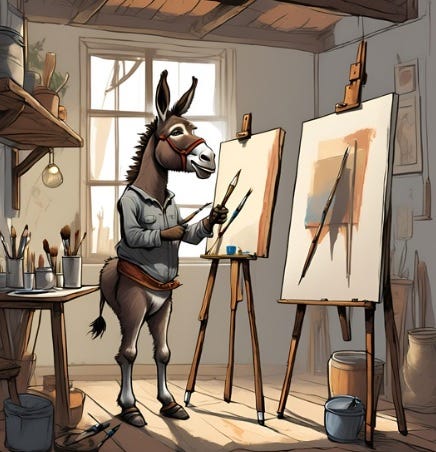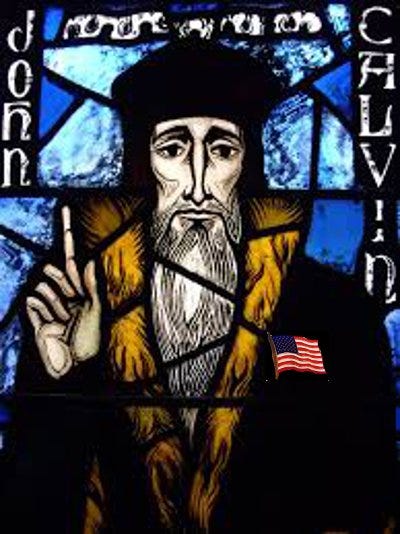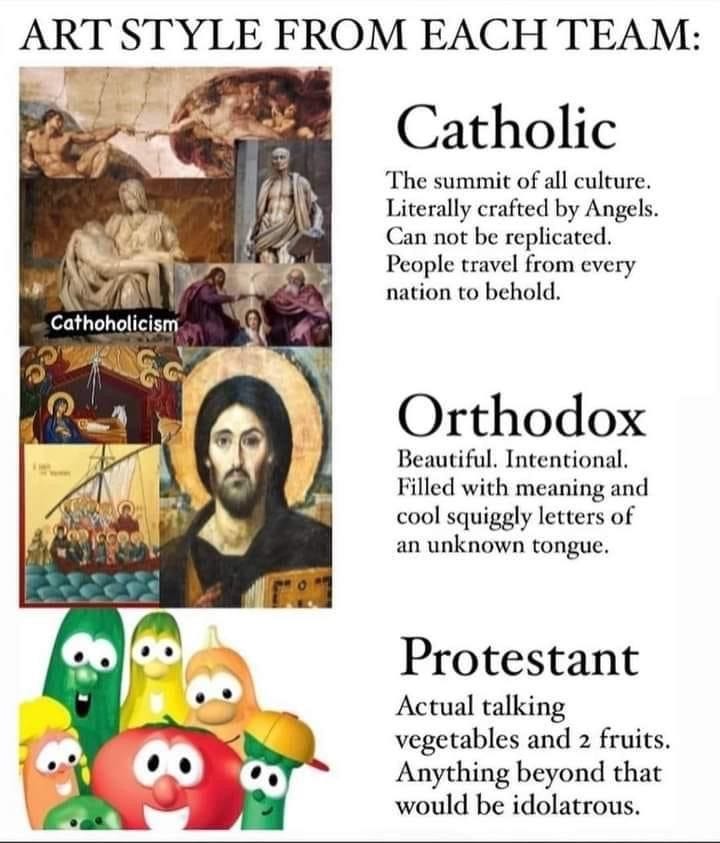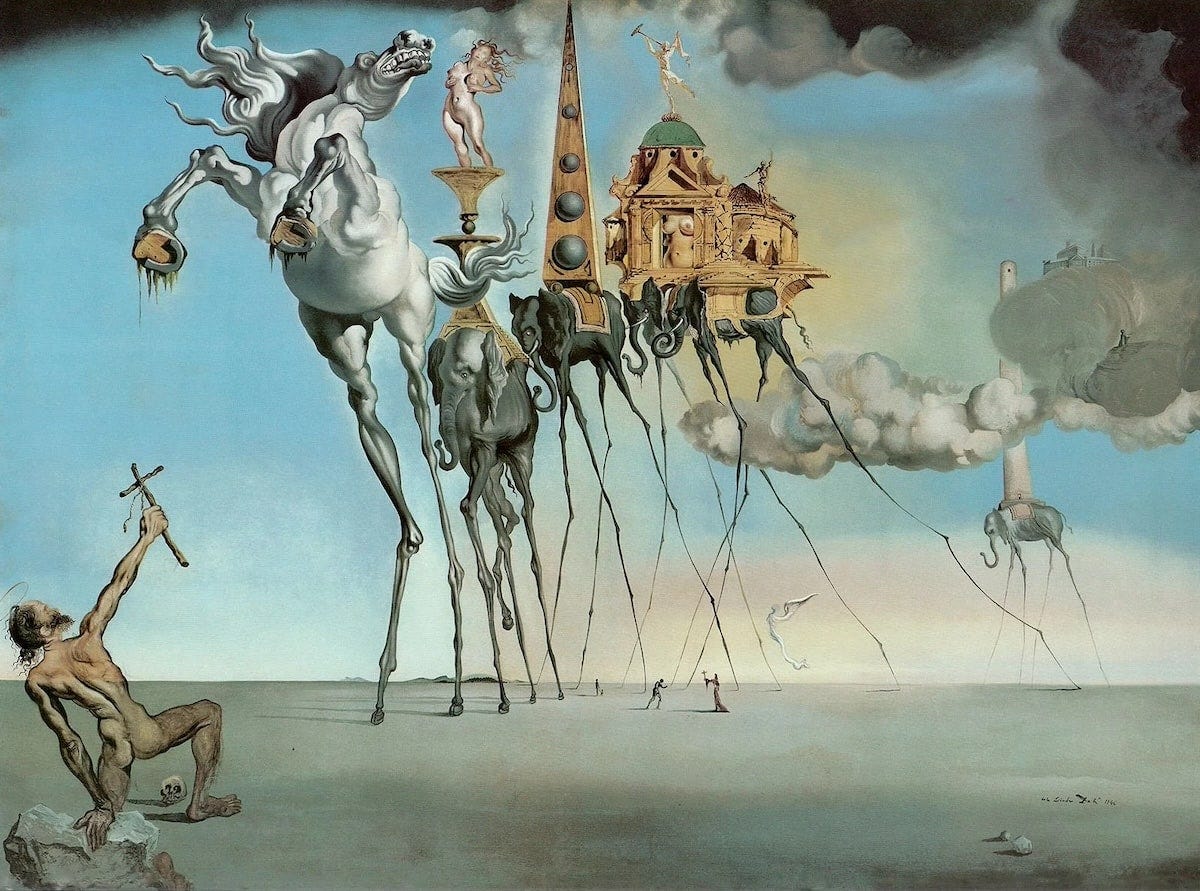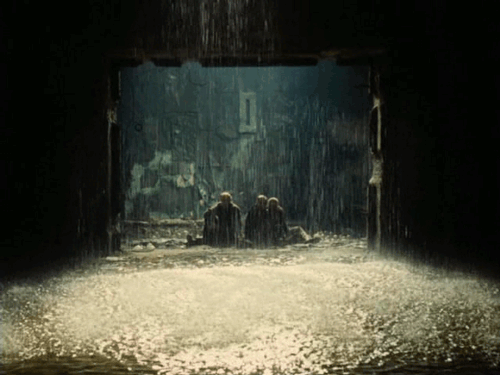Why Are Artists Usually Liberal?
A take on this question which you may not have heard before.
When I wrote my prior article about the prospects of a Christianized version of Saturday Night Live, I ended by asking the readers to ponder why it is that most artists and creatives in the United States are on the liberal/progressive side of the political spectrum. In this article, the Monadnock Review takes its own stab at providing a satisfactory answer, one that we and our contributors hope will pave the way for numerous positive cultural changes that people of varying ideological persuasions can endorse.
To avoid basing a case on the seemingly “obvious” or “self-evident” nature of the charge, let’s introduce several facts to ground the case:
Liberal attitudes of artists can be measured in several ways. In 2015, Mark Edmond of Verdant Labs used data from the Federal Election Commission to determine what percentage of people in various occupations donated to which political parties (the amount of money donated was not a factor). From his data, we see that people involved in Film And Stage Production, Visual Arts and Comedy overwhelmingly donated to Democrats.
Next, compare the 2016 Presidential campaigns of Bernie Sanders and Ted Cruz. Both politicians are known to be hardline ideologues, and both came in second place for their party’s nomination. Sanders received 43% of the popular vote in the Democratic primaries, and Cruz received 25% in the Republican primaries. The difference lies in the endorsements: the roster of first-rate artistic talent, across numerous mediums, who endorsed Bernie is nearly endless. Cruz was endorsed by renowned playwright David Mamet…and not too many others.
The Office (2005-2013) remains one of the most beloved American sitcoms, with an instantly recognizable ensemble cast. Several of the main cast members advertise their politics in interviews and social media posts, and every single one I know of is left-of-center.
Kay Clarity wrote a firsthand testimonial at the Imaginative Conservative blog in 2021: “I am an artistic professional—a singer-songwriter—who is also a political and cultural conservative. Needless to say, it has been a lonely road…outside of perhaps the niche evangelical film and music market, and perhaps areas of the country music genre, the conservative artist is either floundering or hiding in plain sight, never to come clean…I am also privy to a quiet network of others like me in the behemoth artistic liberal metropolis of Los Angeles and beyond.”
What are we to make of all this? Some people would say this partisan preference is inherent: that being people with high openness to new ideas, artists are naturally driven to support gay rights, abortion, transgenderism and vaccine mandates, while disliking armed self-defense, oil production, and White people who are proud of their race. I don’t agree. I’m an artist myself and while I decline to identify closely with American conservatism, there are nonetheless a handful of individual issues I certainly side with the right on.
I want to talk about a cause of the Liberal Artist trend that I don’t often see discussed.
Sources Of American Conservatism
In any nation or society, the conservatives will be the segment representing the dominant, mainstream and heritage aspects of that nation’s values and culture. The leftist opposition will be those who feel disempowered, harmed and marginalized by the mainstream and actively wish to change it. From this starting point, let me highlight four sources of American conservative values, with no assumption that these are the only four that exist:
Psychological Extroversion. Extroverts have a greater need for excitement and stimulation than Introverts.1 Immigrating across an ocean to begin a new life in an unfamiliar land is often exciting and stimulating. The logical conclusion is that first-generation immigrants are usually more Extroverted on average than those who stayed in Europe (or Latin America or Asia), and America, as a “nation of immigrants”, will also be a nation of Extroverts. If Extroverted parents are more likely to conceive Extroverted children (and vice versa), this effect is amplified greatly. Activists like Susan Cain have detailed how American business, religion, education, etc. have been constructed using an A Priori assumption that people are supposed to be Extroverts.
Reformed Theology. 19th century historian George Bancroft wrote: "He that will not honor the memory, and respect the influence of John Calvin, knows but little of the origin of American liberty."2 The New England Puritans were Calvinists, as were other important immigrant groups: Dutch Reformed, Scots-Irish Presbyterians, French Huguenots. The nature of the American State, a federalist republic with separation of powers, is often believed to originate in Calvinist political theory. Also arising from Calvinism: the Protestant Work Ethic which has defined much of American life. Perseverance Of The Saints, the Calvinist idea that “true Christians can never lose their salvation”, remains popular in America to this day.
Scots-Irish Ethnicity. From an ethnic perspective, the United States is, at its core, a Scots-Irish nation. The 18th century waves of immigration from the Scottish-English border region and Ulster Province, Ireland became a plurality of America’s population by the time the Declaration Of Independence was signed in 1776, and no other group was more supportive of secession from Great Britain.3 Many of America’s presidents were Scots-Irish, as were Patrick Henry, Davy Crockett, General Patton, John Wayne, and most of our favourite country musicians. The Scots-Irish narrative became America’s narrative: the westward expansion of pioneers and cowboys who won the day for freedom and individualism. It’s been estimated that more than 10% of America’s population is Scots-Irish, forming much of the White ancestry in the South and Appalachia.
Low-Church Protestantism. The dominant forms of Christianity in America are those originating with the Second Great Awakening (1780-1830). Liturgical clergy is often assumed to be useless for lighting the flames of faith. From these revivals come the Baptists, the Methodists, the Non-Denominationals, and indirectly the Pentecostals, the panoply of loud, emotional religion. NOTE: Low-Church Protestantism usually rejects some of the Five Points of Calvinism, and as historian Nathan Hatch pointed out, “Calvinist” was often used as an epithet by leaders of the Second Great Awakening.4 It’s perfectly possible that the sources of American conservatism can conflict with one another, this is simply about the overall prevailing ideas.
The Artistic Personality
Now that some sources of American conservatism have been identified, consider the personality traits that artists usually possess.
Sensitivity. I think we can all agree that the best art is usually made by people who are sensitive, feel things deeply and reflect carefully on the world.
Intellectually gifted. There are many areas in life where intellectual aptitude is unnecessary for greatness. We’re familiar with the football running back who can sprint like a cheetah, weaving skillfully past opposing players, but can barely perform basic arithmetic. The arts aren’t one of these areas. I think we can also agree that the best art is made by people whose personalities can be described as: “Smart, Interesting and Unusual”.
Idealism. On the Pragmatism-Idealism spectrum, the artist is usually far on the Idealistic side. Many cliches and jokes about artists come from their strong sense of Idealism.
Feelings Matter. People speaking about their favourite artworks will often tell you these works speak directly to the human heart, inspiring it in a way that impersonal, dry logic cannot.
I’ve sung in a parish choir for many years. I play 3 musical instruments and plan to learn a 4th. I’ve written sketch comedy. I can confirm that these four traits are all prevalent in my own personality. But how are they typically treated by the Sources Of American Conservatism?
The American mainstream has always declared that tough, callous personalities are inherently superior to sensitive personalities, that it’s a marker of high value to be blithely unaffected by things, whether those things positive or negative.
Dr. Elaine Aron is a clinical research psychologist who’s investigated the personality trait of Sensitivity for decades and is the primary author of the Highly Sensitive Person book series. While she is quick to point out several advantages of High Sensitivity, a trait she estimates that 20% of all humans have, she’s also written that “the preference for the non-sensitive personality seems strongest in young nations of recent immigrants (e.g., the Americas and Australia)…a study [from 1992] found that in China being a ‘sensitive’ elementary school child is associated with peer popularity; the same characteristics were associated with being unpopular with peers in Canada.”5 And while America is one of the most Extroverted nations in the world, Aron also mentions that, in her experience, about 70% of Highly Sensitive People, the sort who’d make much of the best art, are Introverts.6 There’s a clear cultural mismatch. Despite Susan Cain’s efforts, American businesses still routinely reject job applicants for not being outgoing enough.
Christianity has traditionally viewed Veneration of Icons, painted images of Christ and His Saints, as a necessary way to worship God. Yet, John Calvin and his followers insisted that Icon Veneration was actually “idolatry”, a violation of the Commandment against “graven images”, and they removed Icons from parishes. Even the least iconoclastic Protestants seem to think Icon Veneration is unnecessary. And these attitudes came to America during its Colonial period, creating a national consensus that the visual arts had no place in religion. As far as I can tell, the reduction in the demand for religious art arising from iconoclasm, is the single biggest factor behind the “starving artist” phenomenon. Artists often struggle to be pragmatic, but it’d be much easier for them to develop some pragmatism if iconoclasm hadn’t dried up one of their main income sources.
As for feeling things deeply, a nation founded on Reformed Theology will tend to view Systematic Thinking as superior to other thinking styles, and to choose Systematics as its leaders and role models. The Systematic-type thinkers who find Calvinism appealing are also precisely the sort of people who downplay the importance of our feelings, viewing them as pesky things that prevent us from viewing the world objectively and achieving peak efficiency and productivity. All political ideologies have their slogans, and it’s no surprise that the slogan: “facts don’t care about your feelings” is associated with staunch conservatives in America, not with liberals.
Kay Clarity thinks the conservative’s Achilles Heel is a “tendency toward a utilitarian concern with mammon”, which is exactly what we’d expect to find in a society where the Protestant Work Ethic is one of the foundations deemed worth conserving.
The Scots-Irish, while excelling at the country music genre they created (who doesn’t love Johnny Cash, Dolly Parton or Alabama?), seem in my estimate to only have a small number among their ranks who’d really excel at creating high culture. Senator James Webb of Virginia, who comes from this ethnic group and wrote a history of them titled Born Fighting (2004), mentions that “they scorned aristocracy”, which to me sounds like sour grapes. Thomas Sowell, in Black Rednecks And White Liberals (2005) remarks that spending centuries living in unstable warzones, which is what the Border Region, the Ulster Plantation and the American West Frontier all were, would select against genes for books, businesses and science, and in favour of bold outspoken risk-taking.7 It’s reasonable to assume a stressed-out society in an unstable environment would rarely view a person’s sensitivity as something laudable.
And because the Evangelical movement explicitly aims to appeal to people of average-to-low intelligence and learning, worshippers at these churches rarely have the aptitude to produce an abundance of cutting-edge, timeless music. Intellectually and/or artistically gifted people raised in Evangelicalism often feel neglected and discontent, leaving these churches once they reach a certain age. Contemporary Christian Music, the preferred worship music of the Non-Denominational Church, is frequently denounced (see: South Park’s “Christian Rock Hard” and King Of The Hill’s “Reborn To Be Wild”) as emasculated, saccharine and banal. This is also why many “faith-based” films seem so cringeworthy.
This small list of examples could be elaborated on greatly, but the picture is already clear.
The Artist Scorned
It cannot be said enough: philistine attitudes play a very large role in the United States’ cultural heritage, hence they are also common among those who defend and defer to this heritage. The famous cultural writer Camille Paglia described the United States as: “a practical, commercial nation where the arts have often been seen as wasteful, frivolous or unmanly…American conservatives on the whole, outside of the New Criterion magazine, have shown little interest in the arts, except to promulgate a didactic theory of art as moral improvement that was discarded with the Victorian Era.”8
A similar sentiment was expressed by the Italian-born opera composer Gian Carlo Menotti in 1952, in an essay richly seasoned with comparisons between the American and European artistic worlds: “It is my contention that the average American has little or no respect for the creative artist and is apt to consider him as an almost useless member of the community. The average American father still views with dismay the fact that one of his sons may choose to become a composer, writer, or painter…No wonder that the young American artist is perhaps the most neurotic in the world, and for generations has sought in Europe his spiritual home. There he knows he will not be considered as an exotic member of civilization but as a valuable citizen of the world.”9
The famous Political Compass Quiz contains the statement: “The businessperson and the manufacturer are more important than the writer and the artist”. Agreeing with it will place the taker’s results further into the conservative column.
The life histories of artistic people in America are commonly filled with misfortune: neglected, devalued, mocked, and with a very steep path to becoming part of the middle class. The ranks of leftists are filled with people who’ve been made to feel inferior, marginalized, defective, like second class citizens. The artist is not the sort of person who the American village has likely embraced, and the child who isn’t embraced by the village will burn it down to feel its warm embers.
American conservatives who call for “more conservative artists” have to be willing to modify details of the traditional national culture to achieve this goal. If they’re not willing to concede anything, nothing will change, and I will deafen my ears to their complaints. They cannot have it both ways.
One of the more interesting consequences of this philistinism is the growing Evangelical dependence on a group they’d often considered a great enemy: In 2004, The Passion Of The Christ stunned the moviegoing world with its dramatic, gruesomely violent and utterly faithful rendition of the Lord Jesus Christ’s betrayal and crucifixion. American Evangelicals rightfully adore the movie. But its director, Mel Gibson, is Catholic, as is Jim Caviezel, who played Jesus. The Catholic Church, whatever else one wants to say about it, does not operate under the same philistine, populist presuppositions that much of Protestantism does. It is much more hospitable to art, which is why Catholics seem to punch above their weight when examining the ranks of highly esteemed artists (Michelangelo, J.R.R. Tolkien, Salvador Dali, Flannery O’Connor, etc.) who are also Christian.
In addition to the Catholic aspect, there’s an entire Christian civilization which embraced its artists we can examine.
America Vs. Russia
Hal Freeman is an American-born Christian who first visited Russia in 2002, assisting orphanages in the city of Luga. Russia was in awful shape at the time, just beginning to climb out of the economic collapse caused by the Shock Therapy embarked on during Yeltsin’s presidency. Freeman says that even during those dark days, “things like ballet, opera, dramatic arts, and literature were still very important to the common people. As an American, I normally associated those interests with those in higher socio-economic groups. I would say I have observed a cultural depth here that I had not experienced before coming to Russia.” Russian culture is based around the Holy Orthodox Church, which is neither iconoclastic, nor populist, nor pragmatist, and hence has always been able to find artists among its defenders.
In 19th century Russia, there was a great decline in the Christian Faith, one which would eventually lead to the apocalyptic murderousness of the Bolshevik Revolution. During this century, Nikolai Chernyshevsky’s novel What Is To Be Done? was published, a novel which according to its Wikipedia entry, “inspired several generations of Nihilists and Marxists”, including Vladimir Lenin himself.
Yet even during this period, it was easy to find impeccably talented artists who were conservatives, standing on the side of the Orthodox Church and the Romanov monarchy, against both the rising leftist tide and Western modernity. Two such literary names are Fyodor Dostoevsky and Nikolai Gogol. Dostoevsky ridiculed many of Chernyshevsky’s pretensions, and Gogol believed in a Divinely given mission for Church and Monarchy. In music, we find the devoutly religious Mily Balakirev: pianist, conductor and composer, one of “The Five” composers who strove to develop a distinctly Russian nationalist style of classical music. Balakirev’s hymn “The Angel Cried” is famously sung at Orthodox parishes the world over on Pascha (Easter) Sunday.
In more recent times, we see find novelist-activist Aleksandr Solzhenitsyn, one of the 20th century’s greatest men, and also the filmmaker Andrei Tarkovsky (Solaris, Stalker and The Sacrifice). Tarkovsky was a devout Orthodox Christian whose religious convictions were documented to have profoundly informed his artistic vision. “The true artistic symbol is not a puzzle to be solved, but a doorway through which one can access eternal truths that cannot be reached otherwise.” There is no American Evangelical equivalent to Tarkovsky.
If America were an Orthodox civilization the way Russia historically has been, its relationship with its artists would be completely different. Even if only a plurality in America were Orthodox, and even if one focuses solely on the institution of the Church, we’d find that a large number of formerly “starving artists” would be spiritually fulfilled and financially compensated in the Church, working as iconographers, choir directors, cantors and composers. It’d be an institution that made them feel valued and appreciated, that their work is sacred. It’d be an institution they’d defend from those who disliked it and wished to change it. It’d be some that would make them more conservative.
If Christ is God and King, then the art inspired by Him should be the greatest art in the world. Even a nonbeliever like Camille Paglia asserted that religion would be the means by which American art would be made great. My own quest for great Christian art was part of what led me, someone who was raised Evangelical, into the Orthodox Church. Our church recognizes the unbelievable benevolence and mercy of God and affirms He can bring salvation to people all over the Earth, including to those outside this Church. “If God wishes to grant salvation to some who are Christians in the best way they know, but without ever knowing the Orthodox Church—that is up to Him, not us.”, as Fr. Seraphim Rose put it. But for those who’ve found the thesis of this essay insightful, I’d like to mention that becoming Orthodox is an option you have. Orthodoxy can be something you begin to feel like you belong to, even if you weren’t familiar with it before.
Many Christians in America are rightfully alarmed by the more immoral content created by Hollywood and television, and wage war against “the cultural elites”. In Orthodoxy, we see Christians returning to being the cultural elites themselves, masters in their own house, as they were in the times of Handel, or Michelangelo, or in Orthodox Russia until the very day Communism began its reign.
If you’ve enjoyed this article, please consider supporting The Monadnock Review by buying us a coffee here! A one-time donation of $4 is both less costly and less of a hassle than the long-term commitment of a $5 monthly paid subscription.
See: Cain, Susan. (2012/2013). Quiet: The Power Of Introverts In A World That Can’t Stop Talking. New York City, New York. Broadway Books. Pages 157 to 161.
Bancroft, George. (1855). Literary And Historical Miscellanies. New York City, New York. Harper And Brothers. Page 406.
It was common during the Revolutionary War for the British and their Loyalists to refer to the conflict as “The Presbyterian Rebellion”, Presbyterian being the common religion of the Scots-Irish before the Second Great Awakening.
See: Hatch, Nathan. (1989). The Democratization Of American Christianity. New Haven, Connecticut. Yale University Press.
Aron, Elaine. (2004). “Revisiting Jung’s Concept Of Innate Sensitiveness.” Journal Of Analytical Psychology. 49. Page 342.
Ibid. Page 339.
Sowell, Thomas. (2005/2006). Black Rednecks And White Liberals. New York City, New York. Encounter Books. Pages 5 to 6.
Paglia, Camille. (2007). “Religion And The Arts In America”. Arion, 15.1. Spring/Summer 2007.
Menotti, Gian Carlo. (June 29, 1952). “A Plea For The Creative Artist”. The New York Times. Full text available here.


